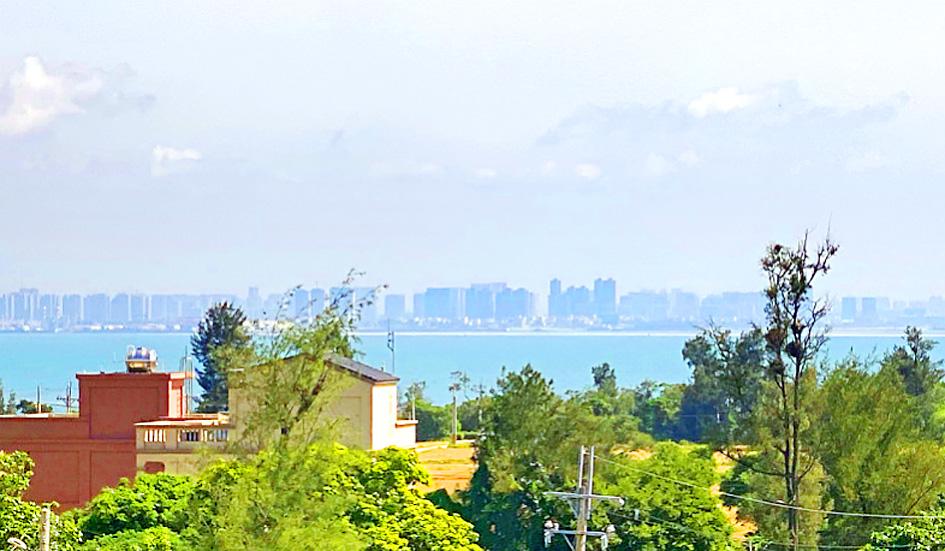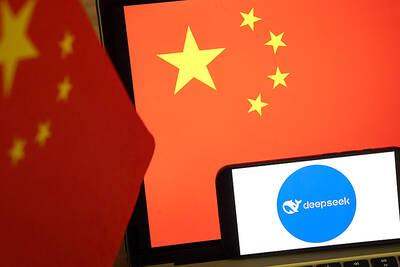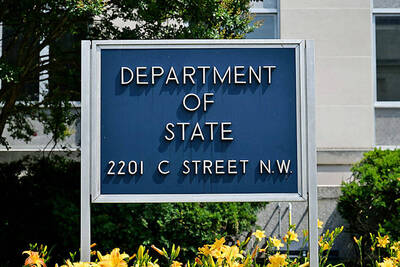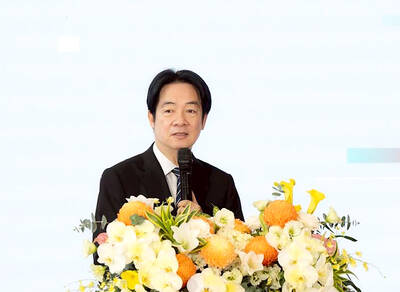Critics accused Taipei Mayor Ko Wen-je (柯文哲) of being oblivious to national security concerns after he proposed constructing a bridge to link Kinmen and China’s Xiamen (廈門).
Ko, who is also the Taiwan People’s Party (TPP) chairman, made the proposal when presiding over the opening ceremony of the party’s office in Kinmen on Saturday.
He said the bridge could solve Kinmen’s population, electricity and garbage problems, as well as serve as a shortcut for leaving or entering Taiwan without traveling via Taipei International Airport (Songshan airport).

Photo: Taipei Times
He also proposed building a hospital in Kinmen to attract people who are seeking medical treatment in Taiwan.
“Try it first and deal with the problems if they occur,” he said in response to national security concerns.
Independent Taipei City Councilor Lin Ying-meng (林穎孟) accused Ko of speaking for China, which she said falsely claimed the Taiwan Strait as “China’s inner sea” on Thursday.
Ko’s idea could pose “serious threats to Taiwan regarding diplomacy and national security,” Lin said.
A national security official who wished to remain anonymous asked whether Ko’s proposal was made rashly without considering national security or was catering to Chinese President Xi Jinping (習近平).
Kinmen would be completely subject to China if a bridge were built, as the People’s Liberation Army (PLA) could occupy Kinmen and put Taiwan in danger of being annexed, they said.
Democratic Progressive Party (DPP) Legislator Wang Mei-hui (王美惠) denounced the proposal as “giving Kinmen away to China,” while DPP Legislator Lin Chun-hsien (林俊憲) asked: “Why does Ko want to risk everything by building a bridge to open up for an invasion by the PLA ?”
Cross-Strait Policy Association secretary-general Wang Chih-sheng (王智盛) said that Ko’s proposal was either ignorant or oblivious to national security issues, which showed that the TPP lacks a central idea regarding Taiwan’s value.
“If a war breaks out, the PLA could quickly advance into Kinmen, which is the first target, before China’s full military assault against Taiwan... Ko is offering the ‘Trojan Horse’ scheme for China to take over Kinmen,” Taiwan Statebuilding Party spokesman Chang Po-yang (張博洋) said.
Ko yesterday said the proposed bridge could benefit economic cooperation between Kinmen and Taiwan proper, as it would eliminate the need for Taiwan Power Co (台電) to allocate an annual subsidy of NT$2 billion (US$67.25 million) to transport fuel to Kinmen for power generation, adding that buying electricity from Xiamen could save NT$15 per kilowatt-hour.
The bridge could further facilitate the “small three links,” which President Tsai Ing-wen (蔡英文) touted when she headed the Mainland Affairs Council, he said.
The comment that a bridge would allow the PLA to easily launch an attack shows “a lack of backbone,” Ko said.
“Why haven’t they thought of it the other way around — that it would be easier for Taiwan’s military to reconquer mainland China?” he said.
Additional reporting by Jason Pan

MISINFORMATION: The generated content tends to adopt China’s official stance, such as ‘Taiwan is currently governed by the Chinese central government,’ the NSB said Five China-developed artificial intelligence (AI) language models exhibit cybersecurity risks and content biases, an inspection conducted by the National Security Bureau (NSB) showed. The five AI tools are: DeepSeek, Doubao (豆包), Yiyan (文心一言), Tongyi (通義千問) and Yuanbao (騰訊元寶), the bureau said, advising people to remain vigilant to protect personal data privacy and corporate business secrets. The NSB said it, in accordance with the National Intelligence Services Act (國家情報工作法), has reviewed international cybersecurity reports and intelligence, and coordinated with the Ministry of Justice Investigation Bureau and the National Police Agency’s Criminal Investigation Bureau to conduct an inspection of China-made AI language

BOOST IN CONFIDENCE: The sale sends a clear message of support for Taiwan and dispels rumors that US President Donald Trump ‘sold out’ the nation, an expert said The US government on Thursday announced a possible sale to Taiwan of fighter jet parts, which was estimated to cost about US$330 million, in a move that an expert said “sends a clear message of support for Taiwan” amid fears that Washington might be wavering in its attitude toward Taipei. It was the first announcement of an arms sale to Taiwan since US President Donald Trump returned to the White House earlier this year. The proposed package includes non-standard components, spare and repair parts, consumables and accessories, as well repair and return support for the F-16, C-130 and Indigenous Defense Fighter aircraft,

CHECKING BOUNDARIES: China wants to disrupt solidarity among democracies and test their red lines, but it is instead pushing nations to become more united, an expert said The US Department of State on Friday expressed deep concern over a Chinese public security agency’s investigation into Legislator Puma Shen (沈伯洋) for “secession.” “China’s actions threaten free speech and erode norms that have underpinned the cross-strait ‘status quo’ for decades,” a US Department of State spokesperson said. The Chongqing Municipal Public Security Bureau late last month listed Shen as “wanted” and launched an investigation into alleged “secession-related” criminal activities, including his founding of the Kuma Academy, a civil defense organization that prepares people for an invasion by China. The spokesperson said that the US was “deeply concerned” about the bureau investigating Shen

‘TROUBLEMAKER’: Most countries believe that it is China — rather than Taiwan — that is undermining regional peace and stability with its coercive tactics, the president said China should restrain itself and refrain from being a troublemaker that sabotages peace and stability in the Indo-Pacific region, President William Lai (賴清德) said yesterday. Lai made the remarks after China Coast Guard vessels sailed into disputed waters off the Senkaku Islands — known as the Diaoyutai Islands (釣魚台) in Taiwan — following a remark Japanese Prime Minister Sanae Takaichi made regarding Taiwan. Takaichi during a parliamentary session on Nov. 7 said that a “Taiwan contingency” involving a Chinese naval blockade could qualify as a “survival-threatening situation” for Japan, and trigger Tokyo’s deployment of its military for defense. Asked about the escalating tensions